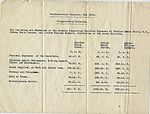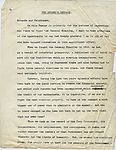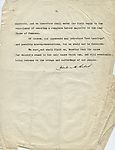 Parliamentary Candidates' Expenses 1929
Parliamentary Candidates' Expenses 1929 Charles Sitch's message to supporters
Charles Sitch's message to supporters Page 2 of the message
Page 2 of the message Labour Party Policy 1928
Labour Party Policy 1928 Summary of Policy p.52
Summary of Policy p.52 Summary p.53
Summary p.53 Summary p.54
Summary p.54 Summary p.55
Summary p.55

Charles' success as a trade union organiser laid the foundation for his political career. The Chainmakers' and Strikers' Association nominated him as a Labour candidate and agreed to pay his election expenses. He was elected as Labour M.P. for Kingswinford in 1918 and held his seat through four general elections, finally losing in Labour's landslide defeat in 1931. In 1930 he was appointed Justice of the Peace for the County of Stafford.
The first image shows the 1929 election campaign expenditure of the parliamentary candidates for the Kingswinford Division. Charles was the sitting M.P. for Labour. Sidney Garcke stood for the Conservatives and Alfred Bowkett for the Liberals. The difference in the total expenditure for each candidate is quite striking. Despite spending the least, Charles retained his seat.
The other images include a copy of Charles' message to his supporters, in which he emphasises the need to raise as much money as possible with which to fight the 1929 election. The "Labour and the Nation" document set out Labour's policy and programme prior to the election, details of which can be seen in the summary.
Charles first entered politics in 1913 as a Liberal Councillor for Cradley Heath ward on the Rowley Regis Urban District Council. He left the Liberals when the party split at the formation of the Lloyd George Coalition Government in 1916. Charles' nomination as a Labour parliamentary candidate came at a general meeting of the Chainmakers and Strikers Association. The result of the ballot showed 1,652 members in favour and only 90 against.
He was elected in 1918 at the "Coupon" general election, so called because of the 'coupon' or letter issued by Lloyd George and Bonar Law, supporting coalition candidates. 63 Labour M.P.s were returned, four of them from the Black Country, Charles Sitch for Kingswinford, F.O. Roberts for West Bromwich, J.E. Davison for Smethwick and A. Short for Wednesbury.
The Dictionary of Labour Biography by Bellamy and Saville gives some insight into Charles' campaign. "Despite very limited funds and an almost non-existent organisation, in a constituency about 8 miles wide, the party did not have a single vehicle at its disposal and Sitch frequently had to walk from and to meetings, an overwhelming personal vote in the chainmaking districts of Old Hill and Cradley Heath brought a majority of 2,888, and maintained him in office until the landslide of 1931."
Charles' impact was less as a parliamentarian and more as an excellent constituency M.P. He was held in high regard by local people of all political persuasions. He became a Freemason. He joined The New Welcome Lodge, which was consecrated in 1929.The documentation relating to the establishment of the lodge claimed that its purpose was to make freemasonry more accessible to the working classes, but the pattern of lodge membership suggests that it was intended from the start as a "class lodge" for Labour M.P.s and officials, which would assist relations between the new Labour Government and Freemasonry. (Labour History Review, Vol.71, Number 1, April 2006, pp9-41)
The period during which Charles represented Kingswinford was an eventful one. It was one of post-war reconstruction and promises of "Homes fit for Heroes". Ireland was partitioned in 1922, and civil war ensued in Southern Ireland. Unemployment was a worrying trend throughout the twenties. Industrial relations were worsening. In 1919, for example, the Government sent troops to deal with 70,000 workers on strike in Glasgow. In 1921 eighty-six million days were lost to strikes. May 1926 saw the General Strike, which lasted for just nine days, with approximately two million on strike. The miners whose demands were at the centre of the industrial action remained locked out until September. The Representation of the People Act gave votes to all women 21 and over. In all there were five general elections, with the Labour Party forming a minority government for a short time in 1924. It formed a government again in 1929, the same year as the Wall Street Crash.
Rollover the captions in the box to see the available images in thumbnail format, click the caption to see the full-size image
| Reference: | 655 |
| Keywords: | |
| Archive Ref: | 2007/001/0044 |
| Updated: | Tue 27 Feb 2007 - 0 |
| Interpretation written by | Barbara Harris |
| Author's organisation | |
| Organisation's website |